.jpg)
Zanele Muholi photographed at Tate Modern, 2024. Photo (c) Tate (Larina Fernandes).
Tate Modern, London
6 June 2024 – 26 January 2025
by ANNA McNAY
The veteran photographer and activist Joan E Biren (AKA JEB, b1944, Washington DC, US), who has been chronicling the lives of LGBTQ+ people since the 1970s, once said: “Without a visual identity we have no community, no support network, no movement. Making ourselves visible is a political act. Making ourselves visible is a continual process.”1 And what JEB did for late-20th-century lesbians, Zanele Muholi (b1972, Umlazi, South Africa) is doing for South Africa’s LGBTQ+ community today.
Walking into the first large gallery of Tate Modern’s mid-career survey show, visitors are greeted by hundreds of pairs of eyes. Black-and-white portraits hung three rows deep, the full length of the walls, give the feeling one might have on entering the long picture gallery of a stately home – only contemporised, of course. Muholi began working on this “collective portrait”, Faces and Phases, in 2006, seeking to document Black lesbian, gay, bisexual, trans, intersex and gender-non-conforming individuals in their home country, and to celebrate and commemorate their lives. The ongoing project comprises more than 600 photographs. Over the years, Muholi has captured the same individuals multiple times, following them on their life journeys – through different phases.
As we journey through the exhibition – not just in this project, but in Muholi’s wider practice – we, as viewers, start to recognise their faces. Each person looks directly at the camera, challenging the viewer to hold their gaze, and these looks are no artistic construct – Muholi is insistent that these individuals are not passive “subjects”, but autonomous and agentive “participants”, involved in a collaboration. As well as visibility, Muholi seeks to give them a voice through the inclusion of personal testimonies. Gaps in the hang denote where participants have died, or where a specific photograph has not yet been taken. The portrait of Muholi’s first participant, Busi Sigasa, is accompanied by a poem Sigasa wrote, entitled Remember Me When I’m Gone, which is painfully poignant, as Sigasa has since died.
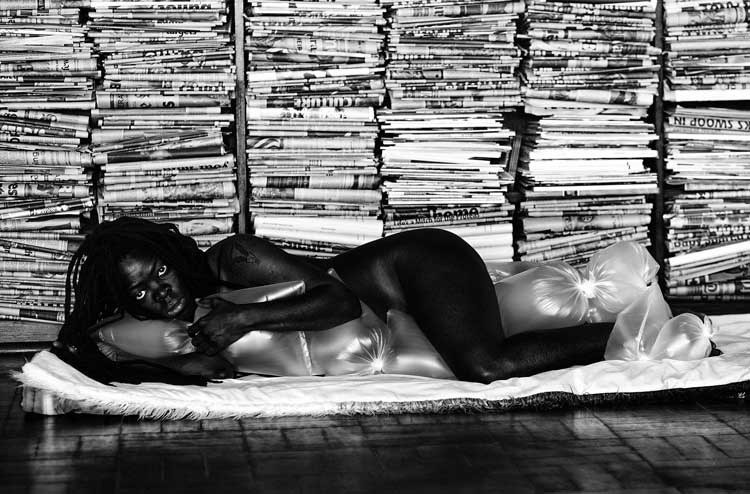
Zanele Muholi. Julie I, Parktown, Johannesburg 2016. Photograph, gelatin silver print on paper, 66 x 100 cm. Courtesy of the Artist and Yancey Richardson, New York. © Zanele Muholi.
Muholi, who identifies as Black, queer and non-binary, and who uses the pronouns they/them/their, refers to themself as a “visual activist” rather than an artist. Art, for them, is a means to an end. “Muholi's visual activism is not an occupation. It’s a lifestyle,” explains former Tate curator Kerryn Greenberg in a short online film. “It's something that occupies them day and night.” Accordingly, the exhibition is proudly people-first, and it is bursting at the seams with love, anger, fear, vulnerability and passion. More than 300 photographs – from Muholi’s very first body of work to their latest and ongoing series – expose the wolf in sheep’s clothing that is South Africa’s position concerning its LGBTQ+ community. Despite having been the first African country to legalise same-sex marriage, in 2006, there are still extreme levels of violence and discrimination, corrective rape and murder.
.jpg)
Zanele Muholi installation view at Tate Modern, 2024. Photo (c) Tate (Larina Fernandes).
The exhibition originally opened in November 2020 in Tate Modern’s Blavatnik building, but was shut down after five weeks because of a Covid-19 lockdown. It returns now after a resoundingly successful international tour, which saw queues down the block in Paris. This iteration does not have all the works from the original, but there are some newly made additions, not least in the form of four giant bronzes – the result of a new departure in Muholi’s practice since 2020.
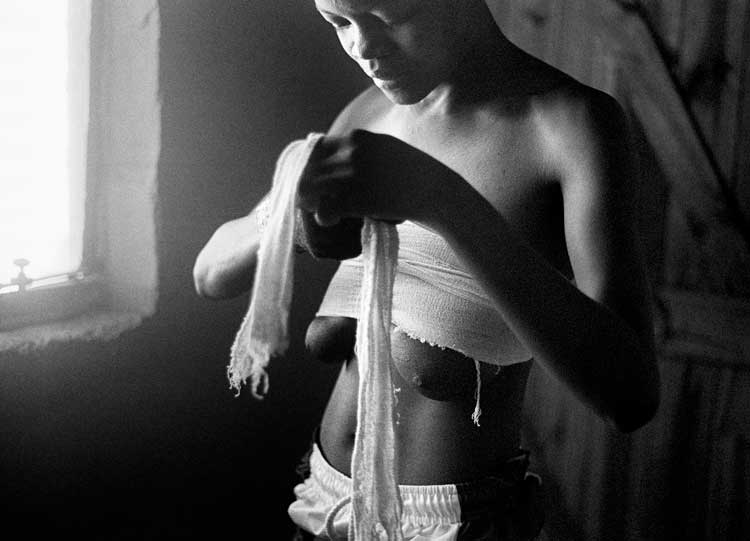
Zanele Muholi. ID Crisis, 2003. Photograph, gelatin silver print on paper, 32.5 x 48.5 cm. Courtesy of the Artist and Yancey Richardson, New York.
© Zanele Muholi
In the small room before the “long picture gallery”, we start at the beginning of Muholi's career with the series Only Half the Picture (2002-06) (thankfully these works survive, since Muholi’s flat in Cape Town was broken into in 2012, and 20 hard drives containing more than five years of work were stolen and have never been recovered.) These photographs were part of Muholi’s work with the Forum for the Empowerment of Women, which they co-founded in 2002, and they document survivors of hate crimes living across South Africa and its townships. Despite their pragmatic approach, Muholi clearly pays close attention to gesture, emphasising the fact that this violence is violence not just to the body, but also the soul. Muholi is adamant, however, that their participants should not be portrayed solely as victims, a sentiment endorsed in the testimony of Lungile Dladla, a survivor of corrective rape, who contracted HIV from the attack, which ends: “I am not a Victim but a Victor.”2
Muholi’s work was first shown in South Africa in 2004 and, although generally well received, it unsurprisingly sparked controversy. A page from the visitors’ book from a group exhibition at the Gender and Visuality conference, held at the University of Western Cape in 2004, where Muholi’s work was included, reads (unedited for grammar and spelling): “It is truly unacceptable for you to undermine our races especially black portraying nudity and sexual explicit content images as if they are the only one who are involved these inhuman activities. After all Black was African and proud of its roots and cultures until you came and inflicted pain and trash to our community.” This belief that homosexuality is something new, a colonial import, is something Muholi seeks to debunk in a later gallery, where they display a timeline providing political, historical and social context, alongside archival material and film footage from, for example, the three-hour-long speech given by Nelson Mandela at the Rivonia Trial in 1964 (which led to his sentence of life imprisonment) and Africa’s first lesbian and gay pride parade, held in Johannesburg in October 1990. This display places Muholi and their practice squarely within South Africa’s history of activism, both in relation to apartheid and the emergence of queer rights, at the intersection of Black Lives Matter and LGBTQ+ rights.
Back in the first room, there is a small monitor showing a short documentary film, Enraged By a Picture (2005), which Muholi made in direct response to the criticisms of their first exhibition. At one point the subtitles read: “Why I capture images of sexuality is because I believe that our experiences as Black lesbians add to a history of struggle that has not yet been written or recorded. But our voices are here now, in this visual ‘text’, and perhaps we will be allowed, for the first time, to speak to all the languages and cultures within our communities.”
.jpg)
ZaVa III, Paris and ZaVa I, Paris (both 2013). Zanele Muholi installation view at Tate Modern, 2024. Photo (c) Tate (Larina Fernandes).
Between the long picture gallery and the one with the timeline is another small room, showing images from Being (2006-ongoing). This is an intimate series, tender and playful, capturing everyday moments in couple’s lives. A young couple sits, looking into the distance and laughing, arms and legs entwined. In another picture, they huddle by the stove, sharing a kiss. This openness shows the level of trust their participants place in Muholi, who is not afraid to insert themself into the work. Looking at ZaVa III, Paris and ZaVa I, Paris (both 2013) is like squinting through a windowpane, partway through it being washed. Muholi smeared Vaseline on to the lens to create, in their words, “a cinematic feel”, but there is also a sense of voyeurism and scopophilia (they raise the issue of the fetishisation of the queer Black body), peering in uninvited at something private. In ZaVa I, Muholi’s gaze (from the one eye visible) meets ours, and we feel caught red-handed, guilty and ashamed of our intrusion.
.jpg)
Right: ZaVa IV, Bordeaux, 2013, part of the Being series. Zanele Muholi installation view at Tate Modern, 2024. Photo (c) Tate (Larina Fernandes).
ZaVa IV, Bordeaux (2013), in the same series, is possibly my favourite image in the exhibition. It shows the couple sitting close, Muholi’s gaze downcast, pensive, sad, with their partner gently kissing their right temple. Together as one, they are wrapped in a white sheet, all at once virginal, suggestive of marriage and happy unison, and funerary, like a shroud. The composition evokes the silhouette of a pietà, resonating love, suffering and loss, as well as the suggestion of salvation and hope for future generations.
And then there is Ncinda (2023). Taking up significant space in this intimate and barely lit room, this is one of Muholi’s new bronzes. At first, I thought it might depict a swan, with a long, elegant neck and two bulging wings, but no, it is in fact the full anatomy of a clitoris. Taboo even here in London (the dictate function on my computer substituted asterisks for the word), this is, when it comes down to it, just another bodily organ, and one that has been – and horrifyingly still is – subjected to appalling violence in cases of, for example, female genital mutilation, a practice still prevalent in many parts of Africa, the Middle East and Asia.
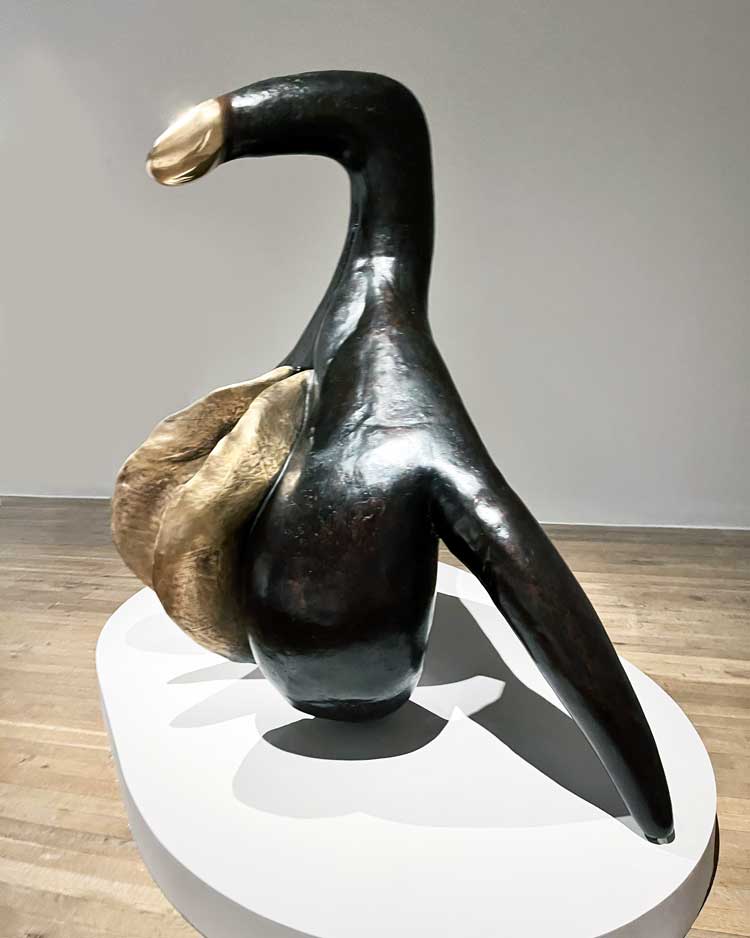
Zanele Muholi. Ncinda, 2023. installation view at Tate Modern, 2024. Photo: Anna McNay.
Ncinda is an isiZulu word (Muholi’s native language) that translates as “doing with the hands” or “squeezing” – I don’t think I need to elaborate on this double entendre. The surface of the main part of the sculpture has been coloured and/or textured, with just the tip – the glans clitoris – polished to a smooth golden sheen. This made me think of the act of “statue rubbing”, when a part of a statue is touched or kissed by the public in the belief that it will bring them luck or have their prayers heard (for example, the right foot of St Peter in the Vatican – perhaps not, in itself, the most obvious counterpart to Muholi’s oversized sexual organ).
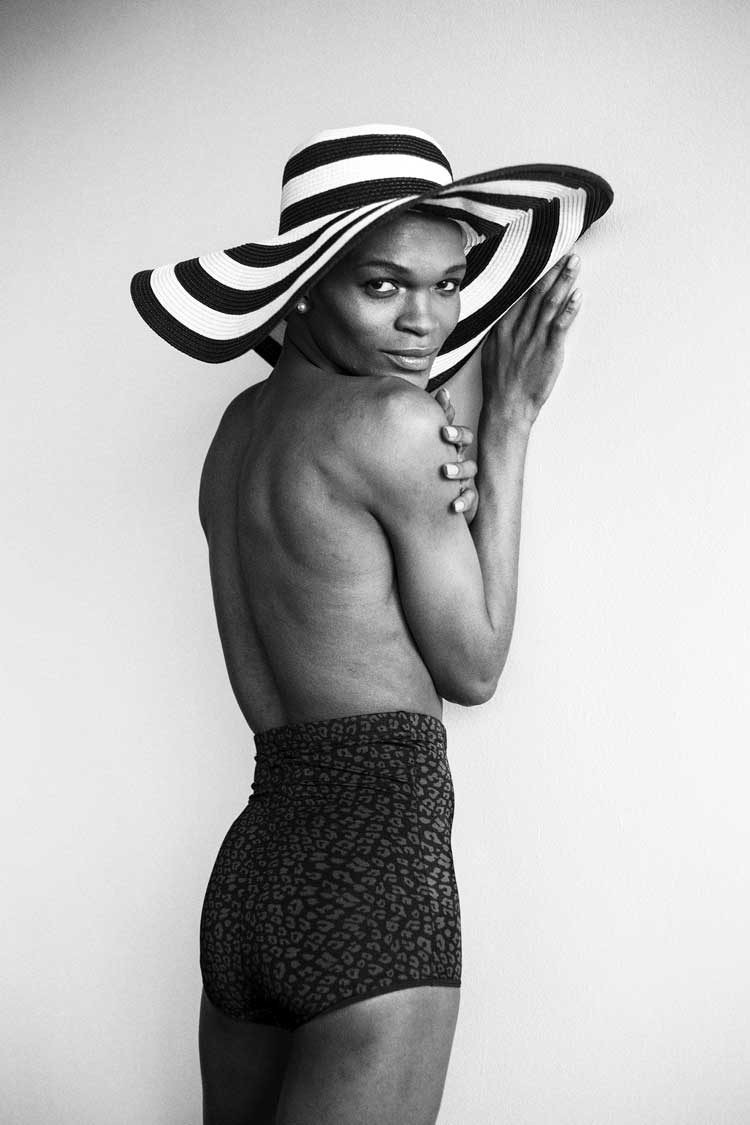
Zanele Muholi. Yaya Mavundla, Parktown, Johannesburg,2014. 200 x 133.3 cm. Courtesy of the Artist and Yancey Richardson, New York. © Zanele Muholi.
The next gallery is more public than private, with, as already described, the archival and contextual exhibits, but also large colour images, in a section titled Queering Public Space, in which participants are encouraged to be their whole, authentic, vibrant selves. The far wall is wallpapered with a joy-filled crowd on a beach – a space that was segregated under apartheid. Here, the bikini- and swimsuit-clad participants flank the stellar Candice Nkosi – Miss Gay South Africa 2019/20 – who stands proudly in the centre with her crown.
.jpg)
Zanele Muholi installation view at Tate Modern, 2024. Photo (c) Tate (Larina Fernandes).
She reappears in the next room, too, in the series Brave Beauties (2014-ongoing), inspired by fashion magazine covers. Many of the participants in this series have been beauty pageant contestants, and I was surprised to learn that Muholi won second place in such a pageant in 1997. They explain that many “enter beauty pageants to change mindsets in the communities they love in”, adding that they provide a space where participants can express their full beauty outside the confines of heteronormative norms. An immense reclining bronze sculpture of Muholi takes this one step further, absolutely subverting the reclining Venus of the – western, white, male, heterosexual, cisgendered – art historical canon.
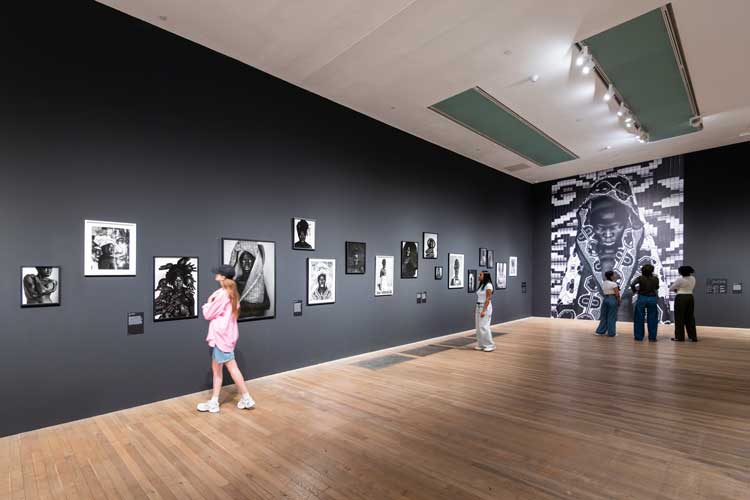
Zanele Muholi installation view at Tate Modern, 2024. Photo (c) Tate (Larina Fernandes).
Following another small room, replete with sofas, in which a loop of testimonials is being played, we reach the most visually impactful gallery. Hanging on deep black walls are myriad images of the artist, in a series called Somnyama Ngonyama (2012-ongoing). Greenberg suggests that these self-portraits might “more accurately [be] presented as self-projections”, continuing: “In them, there is this sense of unapologetic selfhood.” Indeed, Muholi states that they are “reclaiming [their] Blackness,” something which they exaggerate by altering the contrast of the photographs to make their skin appear even darker. In Zamile, KwaThema (2016), they pose shrouded in a striped blanket, reminiscent of the blankets used in South African prisons during apartheid. Muholi says: “For me, this material represents a material for mourning.” In Nolwazi II, Nuoro, Italy (2015), on the other hand (a title that translates as “knowledge”), they have multiple felt-tip pens pushed into their hair. This, we learn, refers to the “pencil test”, a practice devised to assist the South African government in attempts at racial classification under apartheid. When authorities were unsure whether a person should be classified as Black or white, a pencil would be pushed into their hair. If it fell out, signalling that their hair was straight rather than afro-textured, the person “passed” and was classified as white; if it remained standing, they were labelled as Black.
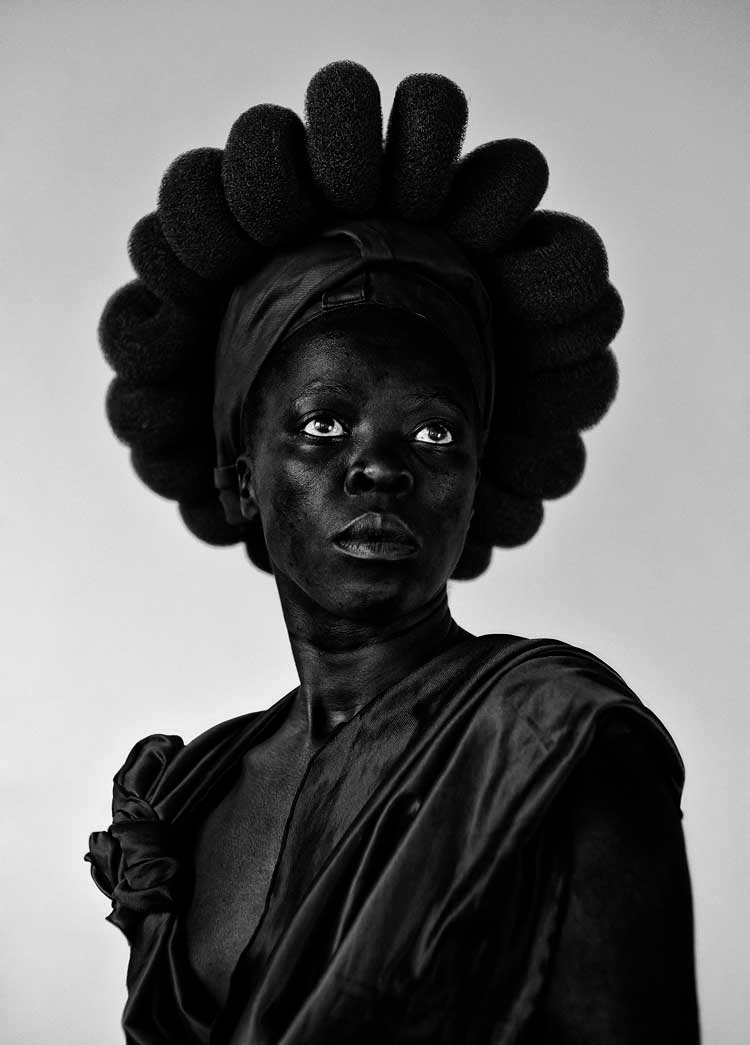
Zanele Muholi. Ntozakhe II, Parktown, 2016. Photograph, gelatin silver print on paper, 100 x 72 cm. Courtesy of the Artist and Yancey Richardson, New York. © Zanele Muholi.
Muholi takes these self-portraits everywhere, all around the world, many of them in hotel rooms, and in all of them they are wearing costumes they have fashioned themself. “I wanted to find an artistic expression to deal with the painful experiences that I was going through by drawing back to historical moments,” they say. “I needed to remember me.” They have also made multiple images in which they pay homage to their mother, Bester, who single-handedly raised a family of eight children, and who died in 2009. In Bester VII, Newington Green, London (2017), for example, Muholi wears a piece of pleated fabric by the Japanese fashion designer Issey Miyake. As a domestic worker, their mother would not have been able to afford such luxury, and so Muholi “wanted her to look and feel good to release her from that fixed position of servitude”. They accordingly not only pay respect to their mother, but also explore personal history and collective memory, as well as ideas of plurality and fluidity of the self. For Muholi, their use of pronouns goes beyond gender identity – it acknowledges their ancestors and the many facets of their identity. They say: “There are those who came before me who make me.”
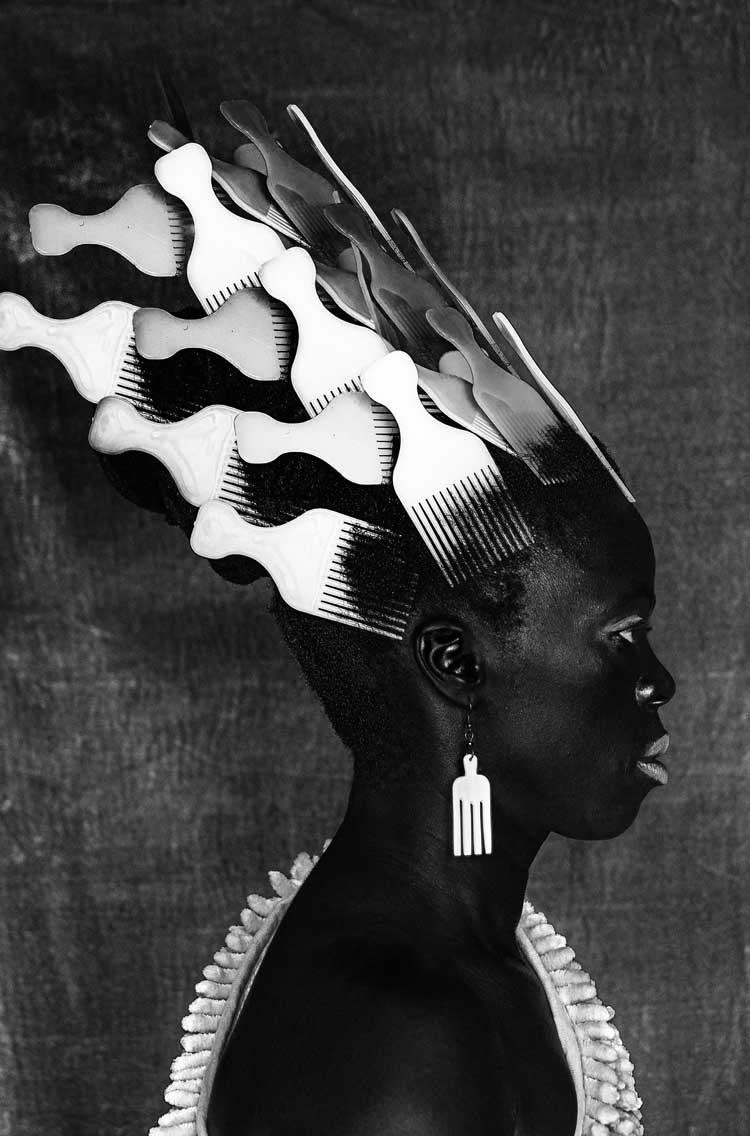
Zanele Muholi. Qiniso, The Sails, Durban, 2019. Photograph, gelatin silver print on paper, 39.9 x 26 cm. Courtesy of the Artist and Yancey Richardson, New York. © Zanele Muholi.
Other works in the Somnyama Ngonyama series deal with healing. The triptych Zibandlela, The Sails, Durban (2020), for example, remembers the South Africans who lost their lives in the first year of the pandemic, with the motif of hair washing referencing the water rituals linked to purification. Similarly, Manzi I, West Coast, Cape Town (2022) which is blown up larger than life as wallpaper, shows Muholi in the sea, submerged nearly to shoulder height, the black-and-white contrast once again intensified, performatively cleansing themself – although I can’t help but think the glistening drops of water, rolling off Muholi’s pitch-coloured skin, seem to have the viscosity of oil. Facing this work, there is another of Muholi’s sculptures: Mmotshola Metsi (The Water Bearer), The Brave II (2023). Here, Muholi rises from the ground (submerged to much the same depth as in Manzi I) carrying above their head a vase decorated with uteri. This signifies the artist’s ability to hold people’s lives and stories.
.jpg)
Mmotshola Metsi (The Water Bearer), The Brave II, 2023. Zanele Muholi installation view at Tate Modern, 2024. Photo (c) Tate (Larina Fernandes).
The final room in the exhibition focuses on connectivity and the coming together that is so central to Muholi’s work: activism extending far beyond the camera. There are photographs of Muholi’s community, by themself and others, from weddings and funerals, as well as protests and marches. A film – We Live in Fear (2022) – shows Muholi at work, putting their participants at ease. It also, however, provides testimonies that contextualise the tragic deaths and funerals depicted: one story, for example, is that of Noxolo Nogwaza, who, we learn, was brutally murdered, her head crushed against a wall, her teeth scattered all around.
The exhibition is also accompanied by a soundscape, created by the South African singer and award-winning musician Toya Delazy. Her unique response to each section of the show, including Zulu sound baths, can be accessed via QR codes displayed in each room.
Finally, there is a “mini reading room” by the exit, which assistant curator Amrita Dhallu describes as a space in which to “decompress”. This certainly is an exhibition that packs a hefty punch. It is, as Muholi intends, beautiful, but, although there is celebration and joy in many of the pictures and stories, there is also much pain, torture and trauma. And medieval as much of it sounds, it goes on, even today. “I am rewriting a Black queer and trans visual history of South Africa for the world to know of our existence, resistance and persistence,” says Muholi.3 “I want to say, ‘we exist’. So that existence comes with a visibility that is positive. Photography has given me that space to express the self in ways that I would not have been able to if I used another medium.”4 And as the quotation on the wall as you enter the first gallery says: “Nobody can tell our story better than ourselves.” Even if you went to the 2020 iteration, I say go again. This is a powerful and historic show.
References
1. Cited in Thinking Activism: Zanele Muholi and Queer Photography Histories by Sarah Allen, in Zanele Muholi, exhibition catalogue, Tate Publishing, 2020, page 82.
2. Faces and Phases (2006–ongoing), ibid, pages 70-71.
3. Ibid, page 81.
4. Film by Tate, September 2020, available on YouTube.